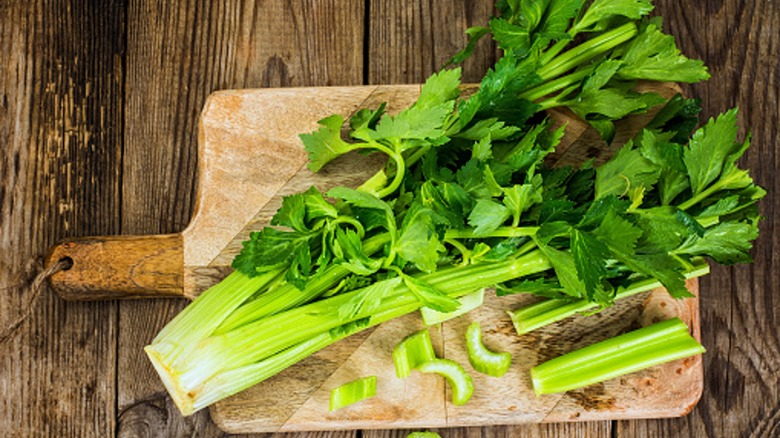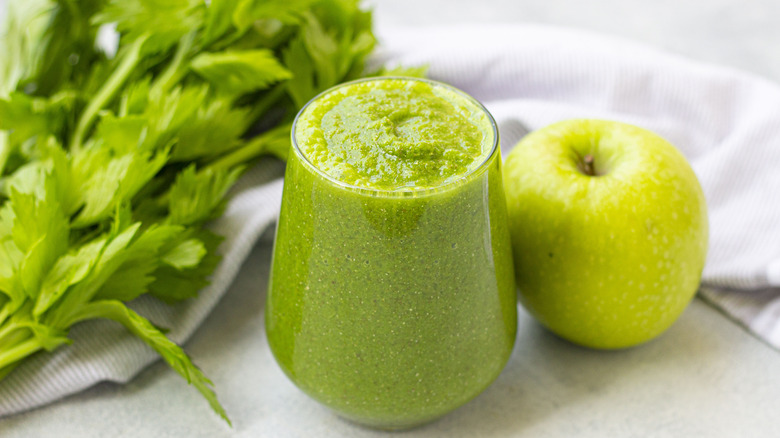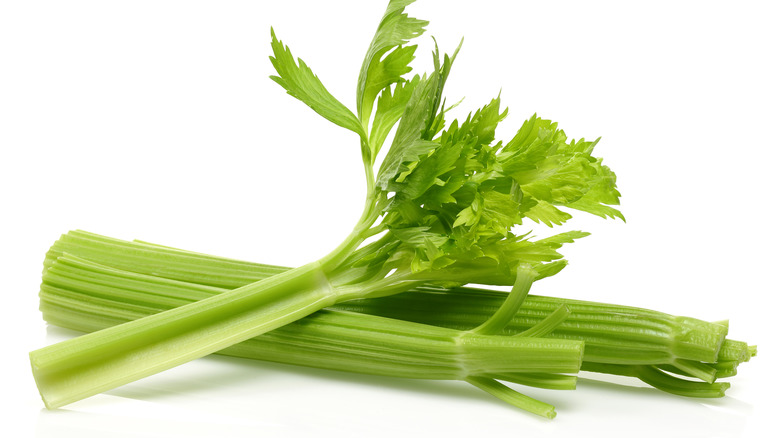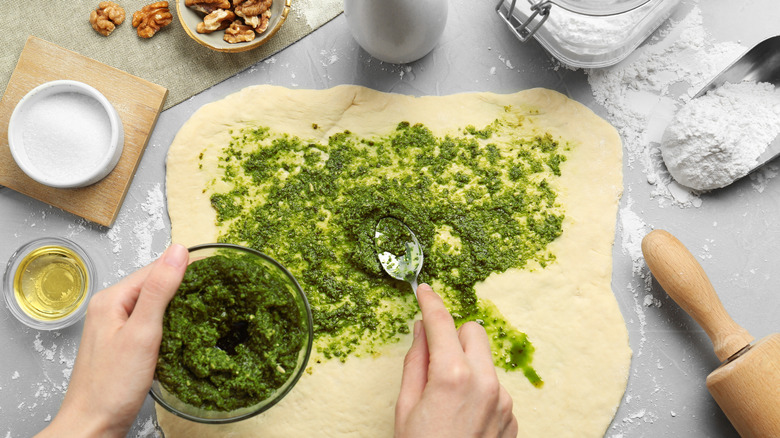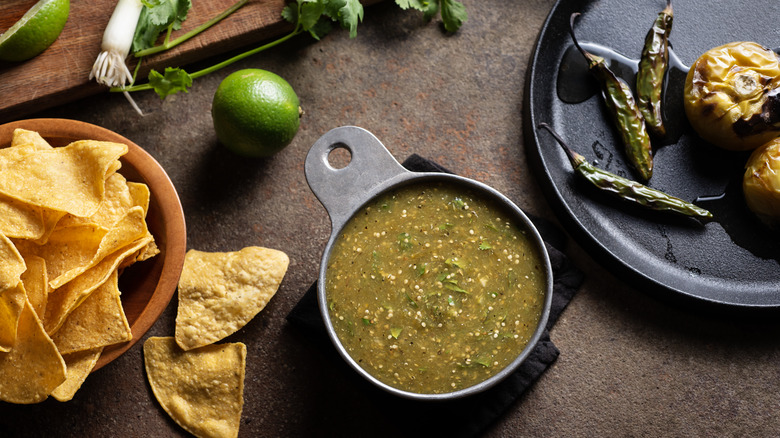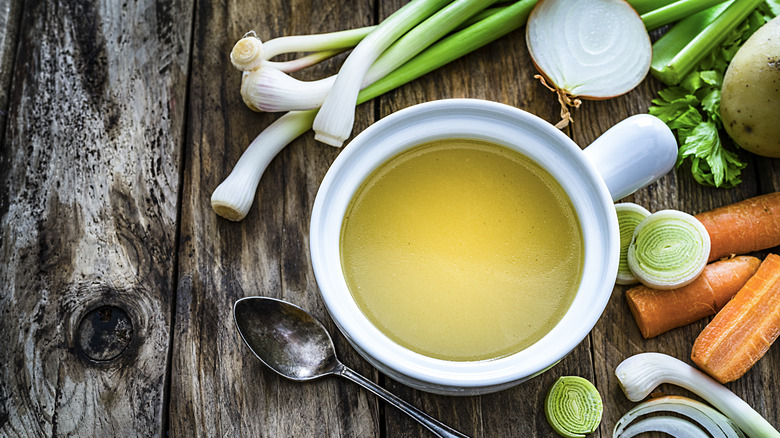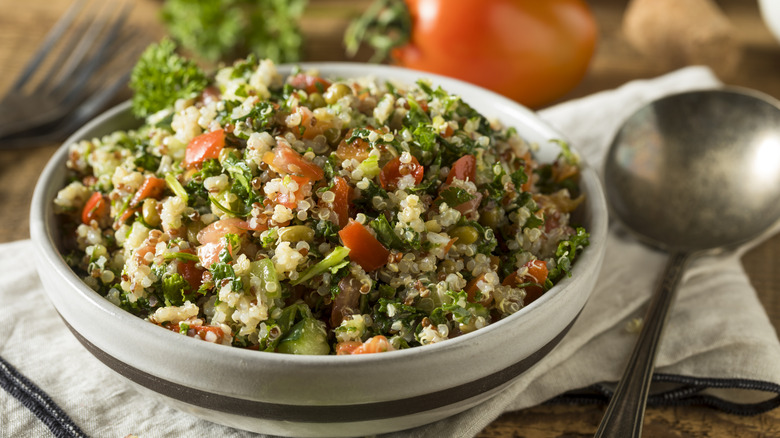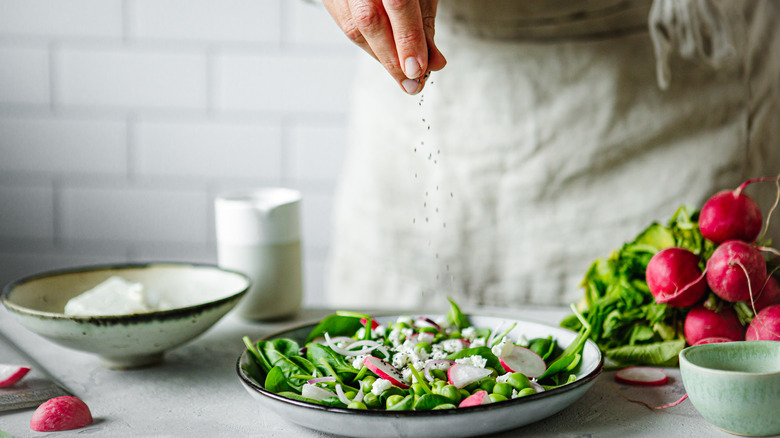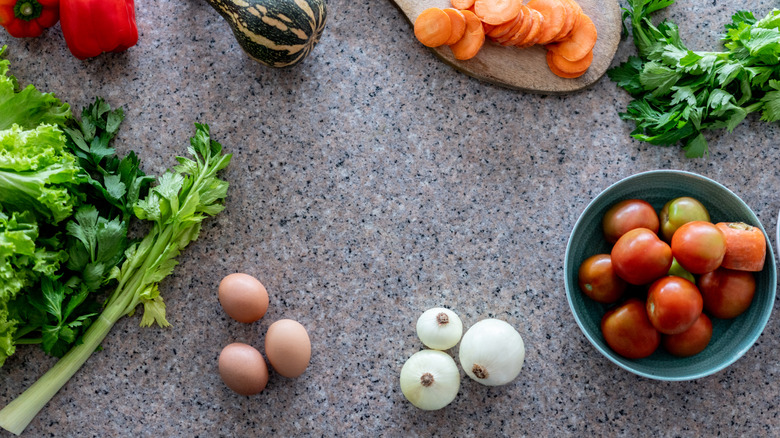10 Ways To Use Celery Leaves In The Kitchen
From celery leaves to carrot tops, the stalks, leaves, peels, and tops of fruits and vegetables are often tossed aside without a second glance. They are commonly categorized as waste when, in reality, they are both a nutritious and tasty part of the ingredient — and ones that can add some pizzazz to your favorite recipes.
This is no exception when it comes to celery leaves. The fibrous stalks are often used in soups and stocks and make a perfect snack with some peanut butter on top. But what about the leafy greens attached to the stalks of this vegetable? Think twice next time you go to toss away the leaves. Landing a leafy head of celery is a bonus in the culinary world. These nutrient-rich leaves pack a flavorful punch and add dimension to soups, salads, sauces, and much more by providing all the powerful flavors of celery without the stringiness of the stocks.
Celery leaves also offer a nutritional boost of vitamins, minerals, fiber, and macronutrients — including a great source of calcium and Vitamin E — and are a useful digestive aid. In fact, the leaves are some of the most nutritious parts of celery and, as an added bonus, can help reduce inflammation. Whether you cook them or use them raw, hold on to those celery leaves. You'll lower food waste and bring some creativity to the kitchen. Here is some inspiration to get you started.
1. Add celery leaves into a green smoothie
Whether you like to start your morning with a green punch or prefer to make it your lunch, green smoothies are a wholesome, nutrient-rich addition to any meal. The options are limitless when it comes to blending green goodness. Get creative when adding fresh, healthy, and, of course, green ingredients to your blender. The secret to the ultimate green smoothie is a balance of flavors and textures. Not too sweet, not too bitter, not too tart.
Toss in some spinach or kale for the base, cucumber for freshness, green apple or kiwi for a sweet and tarty twist, and lemon juice for brightness. A slice of fresh ginger makes a crispy and gingery green smoothie. And for an almost sinfully creamy and dairy-free smoothie, add in a banana. Before you press the "blend" button, your favorite green smoothie is missing one ingredient that may never have crossed your mind: celery leaves.
Green, nutrient-packed, and with an earthy, celery bite, these leaves are a perfect secret ingredient to the ultimate healthy green smoothie. Chop the leaves off the celery stalk, wash them, and add them to the blender with everything else. Blend until smooth, pour into a glass, and bottoms up. This upgraded celery leaf green smoothie goes down easily, adds an extra dose of vitamins, and gives your digestion a boost.
2. Make a creamy celery leaf soup
One of the more ambitious recipes on this list might just become your new go-to soup. Comforting in the winter and a light meal in the spring, the pale-green celery cream soup is a winner all year long. While you can certainly use up your celery leaves by adding them to a vegetable or chicken soup, why not make them the star of the show with a cream of celery leaf soup? This soup showcases the best of celery's flavor, gives you a powerful nutritional boost, and helps to reduce waste in the kitchen by using up leftover celery leaves.
To start, chop celery leaves, scallions, and garlic. Melt butter and oil in a Dutch oven or sturdy soup pot and saute scallions until soft. Add the garlic and celery leaves and cook for several minutes until the leaves start to wilt. These ingredients create a flavorful base for the soup. Next, add diced potatoes and veggie or chicken broth to the pot and bring everything to a boil. Cook for about 15-20 minutes until veggies and potatoes are tender. The potatoes thicken the soup.
Remove from heat and add heavy cream for a luxurious touch. Put the soup in a blender or use an immersion blender and blend until silky smooth. Season with salt and pepper, drizzle with olive oil, and garnish with fresh celery leaves. Bon appétit!
3. Use celery leaves like fresh herbs
Celery leaves are easy to use in place of fresh, flavorful herbs. That's not to discount their unique potential, as they have a distinct flavor profile of their own. Namely, the leaves taste predominantly like celery. The upside is that the leaves are easier to cook with than the stocks, have a softer texture, and can be used as a garnish — just like other fresh herbs.
While the leaves are worthy of use on their own, they can also take the replacement of herbs like parsley and cilantro should you open your refrigerator in search of fresh herbs only to realize you haven't stocked up on your typical herbs. Or, if you're in the mood for experimenting and a hint of celery flavor, simply use the leaves in combination with other herbs. Sprinkle a few into a soup or stew for a hint of celery flavor. Garnish deviled eggs, pasta, hummus, or grilled fish with a handful of celery leaves. Toss a handful into a salad of fresh greens. Have fun experimenting and get ready to dig into your upgraded recipes.
4. Mix celery leaves into a pesto
Pesto is commonly associated with basil and pine nuts, but this beloved Italian condiment is just as delicious when the ingredients are changed up. Pesto literally means "to crush" or "to pound" in Genoese, so you can comfortably stray from the classic recipe and crush whatever you please with a mortar and pestle. Pine nuts can be swapped for cashews or other nuts and basil can be switched out for other green herbs. They may not seem like an obvious choice, but celery leaves are a perfect fit for a pesto recipe.
Whether you're in a pinch and don't have fresh basil leaves or are simply looking for a way to use up your celery leaves, celery leaf pesto is a quick, easy, and delicious alternative. There are no hard and fast rules with this concoction, which leaves plenty of room for creativity and incorporating additional tips for making the best pesto. Celery leaves can be the star ingredient or, if you are in the mood for a more traditional pesto, use half celery leaves and half basil.
Add the greens, garlic, lemon zest, Parmesan cheese, nuts, salt, and pepper into a food processor. Blend on high speed until it forms a thick paste. Next, drizzle olive oil into the processor and blend on low speed until you get a deliciously creamy pesto. Toss this tasty sauce with pasta, spread it on a panini or sandwich, or spoon a dollop on top of pizza.
5. Blend celery leaves into a salsa verde
Salsa verde is a fresh, spicy, and smoky sauce used abundantly in many Mexican dishes. The sauce's base is tomatillos, which are similar to green tomatoes. A typical salsa verde recipe blends tomatillos with chili peppers, garlic, onion, cilantro, and lime juice. Although they are not found in a traditional salsa verde recipe, celery leaves can seamlessly blend into the sauce. For starters, celery leaves make the perfect substitute for the part of the population who are non-cilantro eaters. The leaves can also be added in addition to the cilantro. Either way, celery leaves complement the tanginess of the tomatillos for an unexpected twist on a classic salsa verde.
To make salsa verde a la celery leaves, broil tomatillos and jalapeños until they are partially blackened. Flip over and continue to broil until blistered and splotchy black all over. While these ingredients are broiling, combine chopped onion, celery leaves, cilantro (if desired), fresh lime juice, and salt in a food processor. Add in the blistered tomatillos and jalapeños and pulse until no big chunks of tomatillos remain. Adjust flavors as desired. Serve with tortilla chips or drizzle the salsa liberally on tacos, enchiladas, tamales, and burritos, among many other mouth-watering dishes.
6. Simmer celery leaves into a soup stock
Veggie stocks are a great kitchen staple to have on hand. Rather than buying boxes of broth, save yourself the trip to the store and use up produce that is past its prime. Making a vegetable stock is a great way to transform many items in your refrigerator, including wilting vegetables and herbs, into a whole new product. Celery leaves are a perfect addition to any homemade stock recipe. If you have a bunch of celery leaves that you're unsure what to do with but don't want to discard, the solution is simple: throw them into a pot and make a stock.
Chop carrot, onion, and celery into about one-inch pieces. Heat oil in a pot on the stove and add chopped veggies along with celery leaves, parsley, garlic, thyme, and bay leaves. The spices and herbs are really up to a personal preference for the flavor profile. The celery leaves blend easily with the other items, highlighting celery notes in the stock. Cook frequently until the veggies are brown and softened. Add salt and water and bring to a boil. Simmer on low for about half an hour to infuse the broth.
Strain the liquid from the vegetables and voila! Your stock is ready to add to risotto, put into a vegetable or chicken soup, or use in a chili or stew.
7. Toss celery leaves into a tabbouleh salad
Celery leaves are most nutritious when consumed raw, but they can be a little tough when eaten on their own. An easy fix that allows you to enjoy them fresh but cuts the bitterness is to chop up the fresh leaves and mix them into a salad. You can toss them with a bed of fresh greens or mix them into a chickpea salad. Another popular way to use celery leaves is in an herbaceous salad like tabbouleh, also known as tabouli.
This fresh, herb-forward Middle Eastern salad blends bundles of fresh herbs like mint and parsley. While there isn't an exact recipe for the salad, an herby tabouli recipe also typically has cooked grains, fresh veggies, and a splash of citrus. Celery leaves blend seamlessly into the mix and are complemented by the flavors of additional herbs and citrus. To make your salad, cook bulgur wheat (couscous and quinoa also work well) and allow it to cool before using. While the grains are cooking, chop up bunches of mint, parsley, and celery leaves. Mince the garlic and dice the tomato and cucumber. Whisk together fresh lemon juice, olive oil, salt, and pepper.
Mix the grains, chopped veggies, herbs, and dressing together and enjoy. You can eat it right away or give it a few hours to rest, allowing the flavors to meld together for an extra zing.
8. Dry the leaves and make a celery salt
Celery salt is a delicious seasoning to have on hand in your spice cabinet. Rather than buy this ingredient at the store, try making it at home. This recipe is a perfect solution to use up celery greens that are too wilted to use fresh while also spicing up your home cooking routine.
Dry out your wilted celery leaves in the microwave or the oven at the lowest possible temperature. This method will preserve the flavor of the leaves. Allow the leaves to cool and then crumble them with your fingers. Combine the dried celery leaves with kosher or sea salt and mix thoroughly. Store in an airtight container and allow the blend to sit for a week or two for optimal flavor.
Once your homemade celery salt is ready, have fun adding it to your favorite recipes. If you are in need of some ideas for using your celery salt, season bloody marys with a pinch of celery salt. Sprinkle some on buttery corn on the cob or a bowl of popcorn, put a pinch on a green salad, add a dash to your eggs, or mix the seasoned salt into potato salad. While this ingredient rarely gets the attention it deserves, it finds its way into more dishes than one imagines. With a fresh batch in your cabinet, don't be afraid to go a little celery salt crazy.
9. Add celery leaves to eggs for pizzazz
When eaten plain, eggs can be pretty bland. But that makes them all the more fun to cook with because you can get creative with how you mix them up. Celery leaves are a great place to start. From frittatas to scrambles, these leaves add a crunchy, flavorful element to any simple egg dish. The sky is your limit when it comes to experimenting with egg and celery leaf combos.
To keep it simple, mix them into a scramble. Beat eggs in a bowl with chopped celery leaves, salt, and pepper. Cook the eggs and top the scramble with some feta and a handful of fresh celery leaves. If you want to step it up a notch, fold celery leaves into an omelet with goat cheese and spring onion. Or, if you're cooking for a breakfast party, try your hands at whipping up a frittata. Anything goes in these egg bakes. Saute chopped celery and leek until soft. In a bowl, whisk eggs and mix in the cooked vegetables, celery leaves, parsley, grated pecorino (or your favorite cheese), lemon zest, salt, and pepper. Bake until set. Serve warm or cold, with a sprinkle of lemon zest and fresh celery leaves on top.
10. Shake celery leaves into a bloody mary
This beloved breakfast cocktail has seen many variations over the years. Bloody marys can be topped with sliders or skewers of shrimp, among many other ambitious additions, so sprinkling a few celery leaves into the mix is hardly a shocking variation. It's not too far off the original recipe, which is commonly served with a stalk of celery. To keep it simple, add a celery stalk to the glass of bloody mary with the leaves still on and call it a day. For a more potent celery flavor, throw some leaves in the cocktail mixture as well.
Make a tried-and-true bloody mary recipe for your next brunch party — with the addition of celery leaves. Combine tomato juice, lemon juice, lime juice, horseradish, Worcestershire sauce, pickle juice, hot sauce, and celery leaves in a blender and process until smooth. The addition of celery leaves is subtle yet adds an herbaceous bite to the savory cocktail. Transfer the mix to a pitcher, season with celery salt and pepper, and chill for a few hours.
To serve, add a shot of vodka and ice to a glass. Fill to the top with bloody mary mix, stir, and garnish with celery stalks, veggies, olives, lime wedges, pickles, or any of your other favorite toppings. Cheers!
